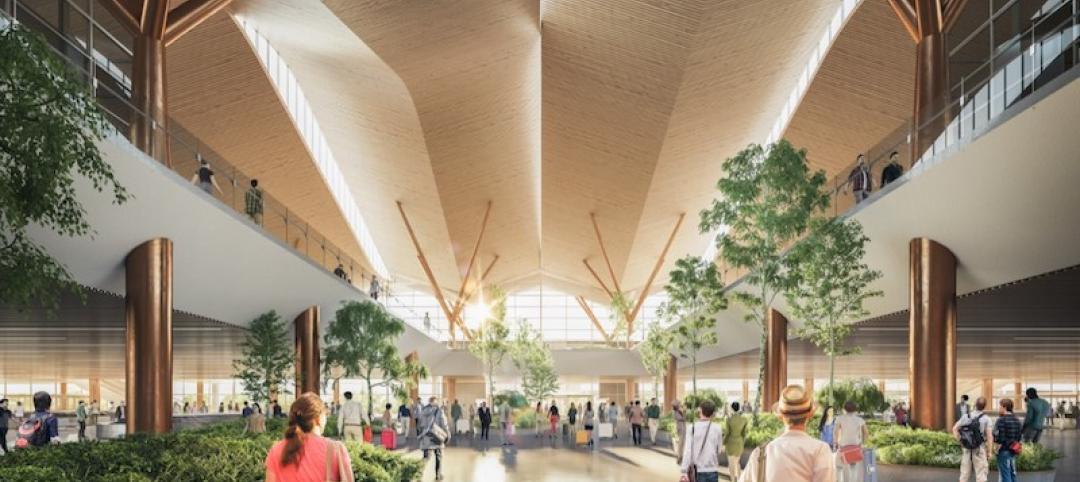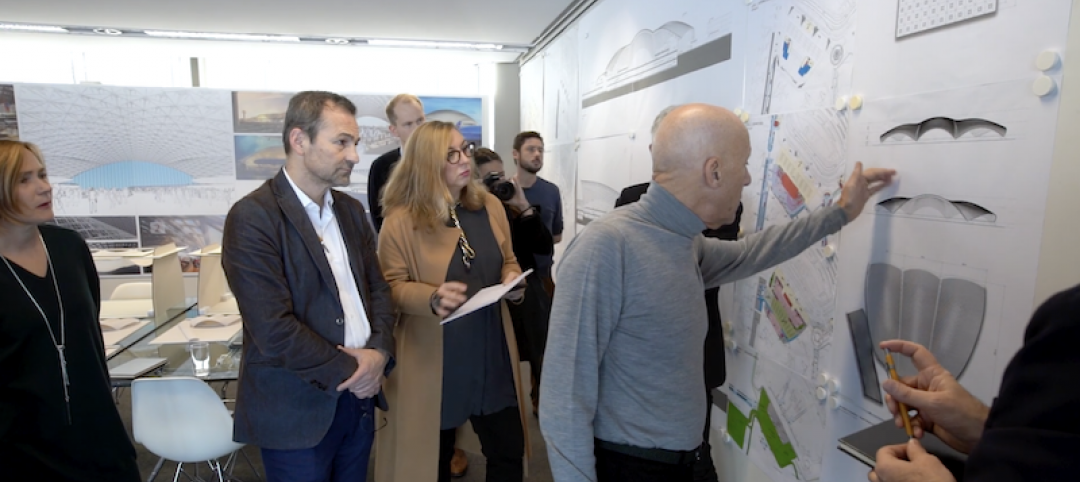Green-oriented reconstruction has generated major buzz in the past few years, even as the commercial building market has struggled. Reports like this year’s “Top 10 Megatrends” from sustainability guru Jerry Yudelson, PE, LEED Fellow, continue to emphasize the potential. Yudelson points out that LEED EB:O+M has been the fastest-growing LEED rating system for three years running, underscoring the current focus on existing buildings. (For more trends information, don’t miss Yudelson’s keynote at BUILDINGChicago.)
The green reconstruction principle transcends HVAC and plumbing upgrades, cladding and glazing improvements, and roof replacement. Increasingly, owners recognize that existing buildings represent a considerable resource in embodied energy, which can often be leveraged for lower front-end costs and a faster turnaround than new construction. The combination of speed, savings, and conservation is powerful in an era when budgets remain tight. Not every building is worth saving, but when the math makes sense, the results can be compelling.
For instance, the University of Cincinnati recently opted to renovate its Morgens Hall student residence tower for $25 million, saving an estimated $15 million compared with an equivalent new project. “We retained the shell, gained square footage in the dorms by enclosing balconies, and reused plant connections instead of having to extend utilities to a new building,” says Jeff Millard, Principal/COO of KLH Engineers. “It’s all about making dollars go farther on buildings and systems.”
Public clients are understandably trying to maximize scarce funds, especially for projects that lack a prestige factor that might attract donors. But private-sector owners and developers are also taking a closer look at existing buildings, with strategies ranging from targeted sustainability retrofits—often involving low-risk Energy Performance Contracts—to complete functional reinventions.
TOP RECONSTRUCTION ARCHITECTURE FIRMS
2012 Reconstruction Revenue ($)1 Stantec $280,352,6522 HOK $134,237,4003 HDR Architecture $114,065,0004 Cannon Design $87,000,0005 Wight & Co. $78,367,6006 HKS $72,000,0007 HMC Architects $62,356,9498 Astorino $55,944,0009 Leo A Daly $55,674,77510 Perkins+Will $54,045,000
TOP RECONSTRUCTION ENGINEERING FIRMS
2012 Reconstruction Revenue ($)1 URS Corp. $292,591,4052 STV $125,755,0003 Wiss, Janney, Elstner Associates $72,500,0004 Science Applications International Corp. $57,788,8755 Middough $54,100,0006 Dewberry $53,086,5197 SSOE Group $52,518,4178 Thornton Tomasetti $50,250,5249 Syska Hennessy Group $49,258,50110 AKF Group $45,000,000
TOP RECONSTRUCTION CONSTRUCTION FIRMS
2012 Reconstruction Revenue ($)1 Structure Tone $2,001,631,4002 DPR Construction $1,581,855,0873 Gilbane $1,555,672,0004 Turner Corporation, The $1,547,270,0005 Whiting-Turner Contracting Co., The $1,103,049,3806 PCL Construction Enterprises $796,283,8337 HITT Contracting $789,024,8068 Pepper Construction Group $753,093,0009 Balfour Beatty $671,639,24710 Barton Malow $597,731,773
Giants 300 coverage of Reconstruction brought to you by Duro-Last www.duro-last.com
For one recent project at Polaris Fashion Place Mall in Columbus, Ohio, FRCH assisted with a renovation and tenant fit-out that required the Building Team to move a pair of 20-ton escalators a quarter of the length of the facility. The project took extensive logistical planning and some overnight labor, but it opened up attractive space for an H&M store and cost about 25% less than new escalators.
“In the heyday of mall development and deal-making, this level of complexity and concentrated focus on saving, reusing, and creative thinking would not have been considered,” says Harkin. “As margins, tenant requirements, and limited new mall product have evolved, we find ourselves part of a new reality.”
When historic properties or urban redevelopment are involved, many states and cities are providing important financial support for reconstruction. Emily Meyer, Associate Developer, Ryan Companies US, says, “Redevelopment of urban core areas and reuse of existing infrastructure provide benefits that are recognized and incentivized by local, state, and federal governments. Reusing existing structures, inherently green, also provides working and living space in higher density, walkable neighborhoods.”
Ryan recently renovated a Beaux Arts federal courthouse as a new City Hall for Cedar Rapids, Iowa, and is converting four stories of Davenport’s historic 12-story Wells Fargo bank tower into apartments. The project will provide needed market-rate housing in place of unneeded offices, while helping to preserve a city icon.
In Detroit, the century-old Whitney Building is the target of a just-announced $82 million reconstruction. Contractor Walbridge will transform the landmark—vacant since 2000—into a hotel and apartment property. The players include Starwood Hotels (which will locate its boutique Aloft brand in the Whitney), the Roxbury Group, and Trans Inns Management. Crucial to making the numbers work: an $8.5 million loan from the Michigan Community Revitalization Program, a $9.8 million state brownfield redevelopment tax credit, and $12.4 million in state historic tax credits.
State or municipal tax support is usually essential for making such large-scale renovations a reality. Government willingness to support the projects reflects growing recognition that reconstruction, not just new development, can produce an economic engine. Minnesota adopted a tax credit for historic rehabs in 2010; Iowa strengthened its program this year; and Wisconsin is also moving to increase its state credits.
The prospect is a bit less sunny on the federal side, however. Last summer, the Third Circuit Court of Appeals disallowed a third-party investment in the historic rehabilitation of a New Jersey convention center. Known as the Boardwalk Decision, the ruling overturned a lower court’s determination and cast a cloud over the interpretation of federal tax benefits for outside investors in historic property reconstruction, according to Ryan Companies’ Meyer (http://bit.ly/BoardwalkDecision). “Until the IRS issues further guidance, investors will remain skittish, keeping many projects from moving forward,” she says.
Related Stories
Airports | Mar 21, 2019
First photos inside the nearly completed Jewel Changi Airport addition
The addition is set to open this spring.
Airports | Feb 28, 2019
Renovation of Tampa International Airport’s Main Terminal completes
Skanska and HOK led the design-build team.
Airports | Feb 26, 2019
Design team unveils Terminal Modernization Program at Pittsburgh International Airport
The terminal’s design philosophy combines nature, technology, and community.
Airports | Feb 21, 2019
Self-service bag drops and the challenges of speeding up airport baggage check-in
More airports are asking passengers to check their own baggage. What’s the ripple effect?
Airports | Feb 10, 2019
Chicago searches for the right design to expand O’Hare Airport and make passenger connections less stressful
Competition finalists took different approaches to rethinking the logistics of a gigantic, hectic space.
Airports | Oct 31, 2018
Foster + Partners’ Mexico City Airport has been cancelled
The project was set to cost $13.3 billion.
Airports | Aug 3, 2018
Airport trends 2018: Full flights with no end in sight
As service demand surges, airports turn to technology, faster building techniques.
Airports | May 31, 2018
Denver's airport city
Cultivation of airport cities is an emerging development strategy shaped by urban planners, civic leaders, airport executives, and academics.
| May 24, 2018
Accelerate Live! talk: Security and the built environment: Insights from an embassy designer
In this 15-minute talk at BD+C’s Accelerate Live! conference (May 10, 2018, Chicago), embassy designer Tom Jacobs explores ways that provide the needed protection while keeping intact the representational and inspirational qualities of a design.
Retail Centers | Apr 19, 2018
Miami International Airport is home to the first Johnnie Walker store in the U.S.
The store will be a permanent fixture in the airport’s North Terminal.

















